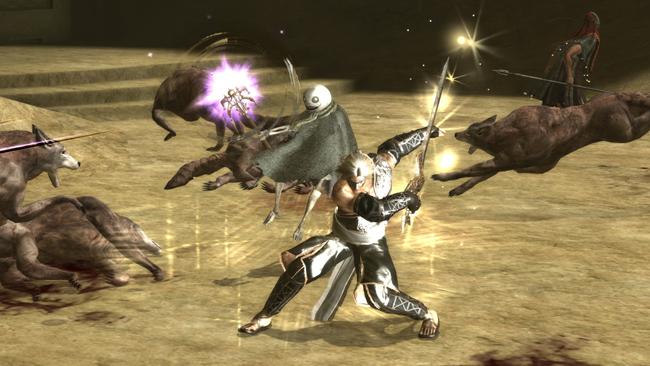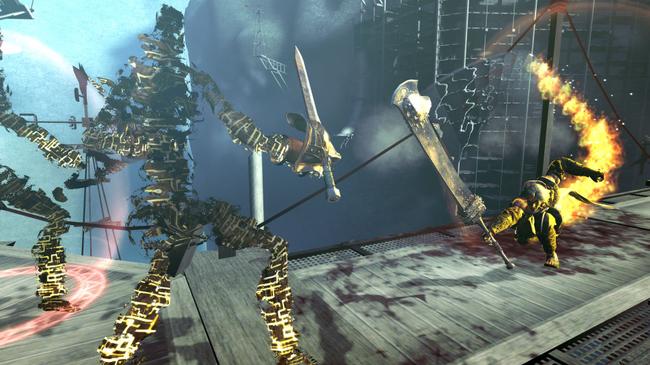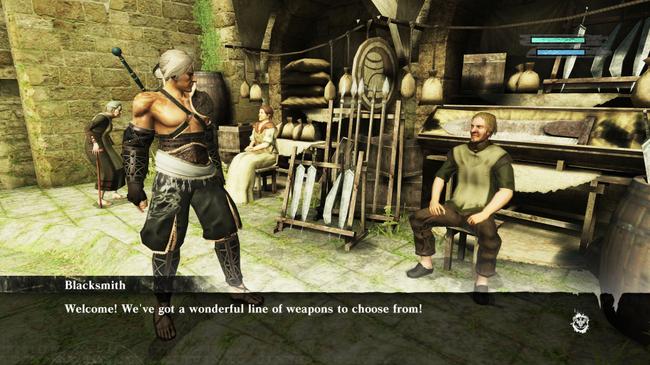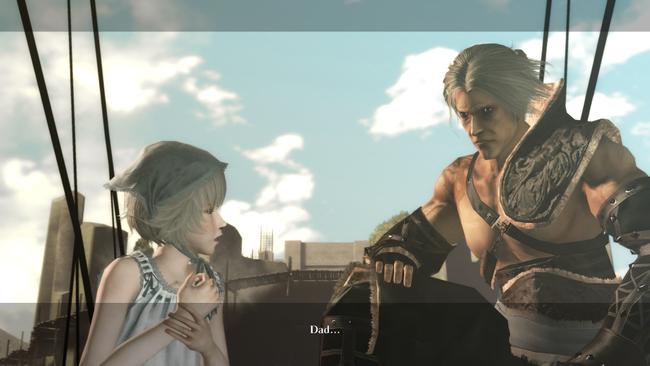Nier Review
Nier is a funny little blip in Square Enix’s pre-E3 line-up for 2010, standing next to the behemoth of Final Fantasy XIII and heavily promoted Western offerings like Just Cause 2 and Supreme Commander 2 as a less publicised, smaller-budget release – in fact, it almost might’ve slipped right under the radar of many - even devout RPG fans.
For those of you who haven’t spotted it before, Nier is a genre-bending Action RPG coming from Cavia, the team behind Resident Evil’s Darkside Chronicles spinoff as well as the PS2’s Drakengard series of RPGs. Nier is actually something of a sequel to the Drakengard games, sharing a universe and some vague elements, but not much else.

The core of the game is an injured, diseased young woman who the player is ultimately tasked with saving. In a curious twist, Japan actually has two takes on the story - one version casts the player as the young woman's brother, the other as her older, gruffer father. The West only gets one version, and it's the latter, with this put-upon father struggling to find a cure to save his daughter from a deadly disease. There’s some interesting stuff in the opening that teases the twists and turns this story will take; the opening takes place in the near future of 2049 before skipping forward 1300 years to a world that appears to have suffered one cataclysm and is now on the brink of another.
There’s a touch of sci-fi to everything that goes on here, with the future world where the lion’s share of the game takes place basically already a wasteland, where glimpses of the old world and little pockets of younger civilization provide most of the character. I’m starting to get tired of those open, rolling, brown fields, and Nier doesn’t help that feeling by sporting flat, boring areas with muddy textures. You’ll be running through too many areas that look the same, and it’s disappointing that a game with such a cool twist on the traditional JRPG and Adventure game formula fails to make its world very visually distinct distinct.
Being an adventure game, the combat isn’t the sole focus of the game, with the third-person hacking and slashing feeling a tiny bit like a Dynasty Warriors style button-masher. The melee action is broken up by magic, enabled by the Grimoire Weiss, a floating, talking, brilliantly pompous magical book. Weiss serves as your ‘Navi’ in the Zelda-style segments of the game, but is also downright funny and also grants the protagonist a bunch of magic powers.
The magic powers vary and level up as the game progresses, but generally speaking Weiss will shoot magical energy at enemies, summon up gigantic deadly blades to swarm around you and other typical magic attacks – projectile, area of effect and so on. This combined with the ability to dodge and roll adds a bit of depth to the combat, making it solid but still rather limited.
Nier’s a rather disjointed experience, with various styles of play welded together in a haphazard manner. The combat lacks depth but is also more than satisfying enough for those with a blood thirst, but the next moment you'll be pottering about a quiet town helping out an old lady for a sidequest, of which there are many. Ten minutes later you’ll be stuck scratching your head at a puzzle in a Zelda-like dungeon, and then as the dungeon progresses you’ll be back in combat mode.

Cavia seem keen to nod to almost every part of gaming history – there’s rail shooter segments, and plenty of areas where the camera gets locked into a specific angle and follows you around in a manner which evokes both Resident Evil and how the camera moved in the NES and SNES Zelda titles. It’s an interesting setup.
Many of the sidequests are mundane and boring, forcing you to trot across the game’s massive but bland-looking overworld, killing animals and shades (Nier’s main mysterious and shadowy enemy), even calling at some points for you to indulge in a spot of fishing or gardening, the former of which is rather frustrating to actually do thanks to no actual serviceable explanation of how it works being present.
Most of Nier’s sidequests and distractions are, like other aspects of the game, solid but wholly unimpressive. What is impressive is the sheer amount of things that you can do – this is definitely more than a linear adventure game or action RPG, providing the player with a veritable deluge of optional tasks - In that respect Nier is the opposite of the ‘story or bust’ approach of Final Fantasy XIII.
All those side quests can be ignored and skipped over if you so desire, and that leaves you with a more manageable Action RPG of around 20 hours in length. I'd recommend you do tackle the side content if you can, however - they're full of unique stories that wildly vary between the quirky and bizarre to the gut-wrenching and upsetting. In the main story, you'll instead be focused on that core quest, with various maguffin tasks between you and curing your daughter. Here you’ll be focused on combat and getting through dungeons and ensuring you’re ready for harder combat challenges by powering up Nier.
Leveling up just happens as you defeat enemies and gain EXP, and offers little in the way of player agency. Players can get involved with another progression mechanic, however - and that's the ‘word’ system. Defeated enemies sometimes drop words, which can then be equipped to weapons and magic to change their properties or buff their powers. The word system is vital to get through the game comfortably, and can do everything from light an enemy on fire to make battles reward you with more experience – it’s all classic RPG stuff.

The dungeons are far better designed than the overworld, with some decent puzzles that’ll leave you confused for a while but slapping yourself when you finally make the connection. On the flip side, sometimes the puzzle is simply where to go - those damn muddy environments can often make that unclear. The end of every dungeon is almost always a highlight with impressive looking and challenging boss encounters.
I was also really impressed by the way the game seamlessly segways between 2D and 3D segments. It’s probably the best and most cool stylistic choice Nier makes, though in certain places it’s questionable, like areas of a dungeon early on that has you fighting enemies from a top-down view like a 16 bit Action RPG. It's clear that the combat system wasn't built for that, with controls that were decent enough for the rest of the game far less satisfying in these secments.
Despite many elements that show a ton of potential and an equally large number that make me cringe, the star of the show is Nier's story. It’s quirky, over the top and aware of the medium in a way which I haven’t seen in a Japanese RPG for some time. Grimoire Weiss is quite the character for a book, constantly wisecracking at the expense of Nier and at the game’s design.
He’ll comment on character designs, the layout of levels and dungeons (because seriously, who would build a place as complex as half these dungeons?) and has a fair amount to say about all of the key characters you encounter throughout the adventure, including stand-out ally Kaine, a much publicised sparsely dressed character with a foul mouth and a particularly compelling backstory.
Both the original writers in Japan and the localization team deserve an enormous amount of credit for this story; it's an impressive piece of work that has converted over to English well. The narrative takes a game that is ultimately mostly mediocre and adds something truly special to it. Even if you tire of the gameplay, many players are likely to find more than enough in the story to drive them through its events.

Indeed, you might find yourself playing through the story multiple times to this end. To see the real, true ending of Nier you'll need to complete it multiple times, with each subsequent play-through and certain choices made therein dramatically altering either the path of the story, or how certain elements within it are presented. Any game that asks you to play it multiple times has a confidence that could easily be an act of folly - but in its gradually unfurling narrative, Nier provides much to love to encourage those replays.
You won't just fall for the brilliant-but-bizarre stuff, either. Kaine's cursing and Weiss' rants are great, but the story of Nier experiments with interesting ideas and themes beyond its simple damsel-in-distress setup. In narrative terms, this one might be so much as a classic.
Speaking of classic - something RPG fans always love is a good soundtrack, and if we scored individual bits of a game differently here on RPG Site the score for Nier's soundtrack would undoubtedly be a ten. Strong melodies used for character themes with pierce your brain and be used at the perfect moment to emotionally skewer you - it's brilliant. It’s a greatly varied, unique soundtrack that is diverse and crazy as the game it’s for.
Diverse is a good word to describe Nier in general – or perhaps eclectic. On the surface from the opening sequences or perhaps if you merely watched somebody else play the game might seem mediocre and boring – and it is in places – but the interesting mixture of multiple gameplay styles, bizarre but delightful story and superb soundtrack more than make up for the issues and, yes – pushes Nier to be above average.